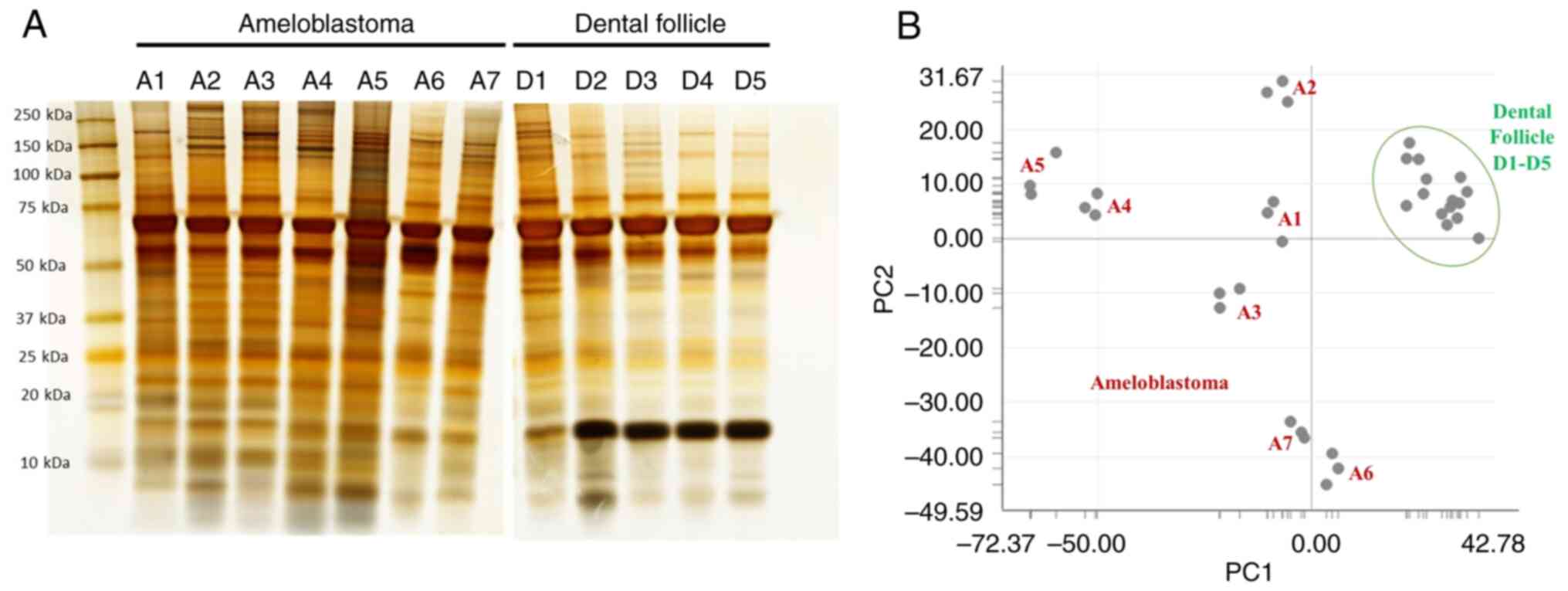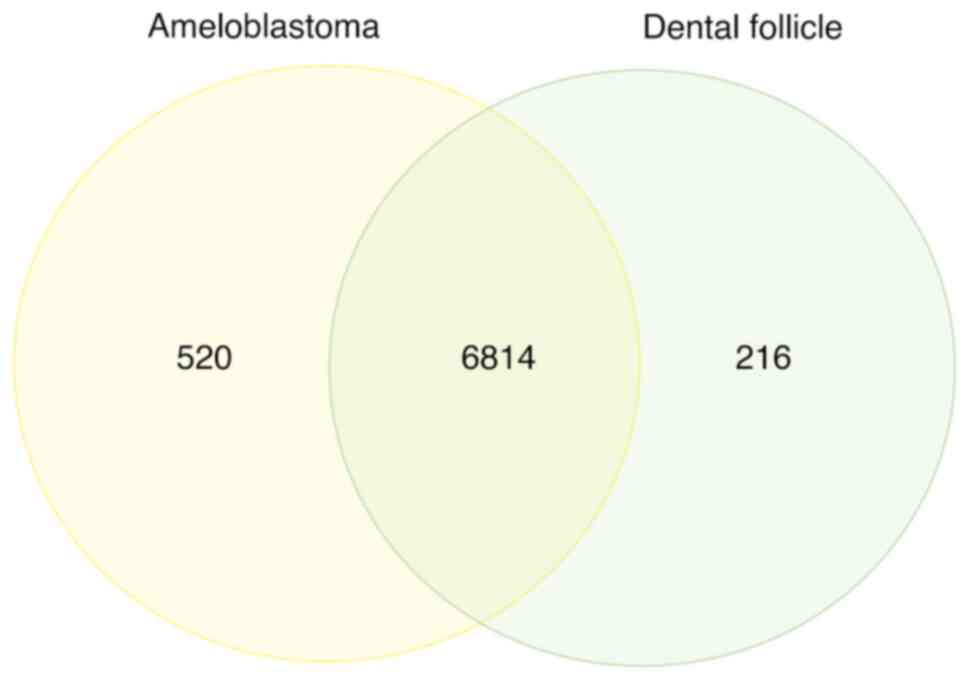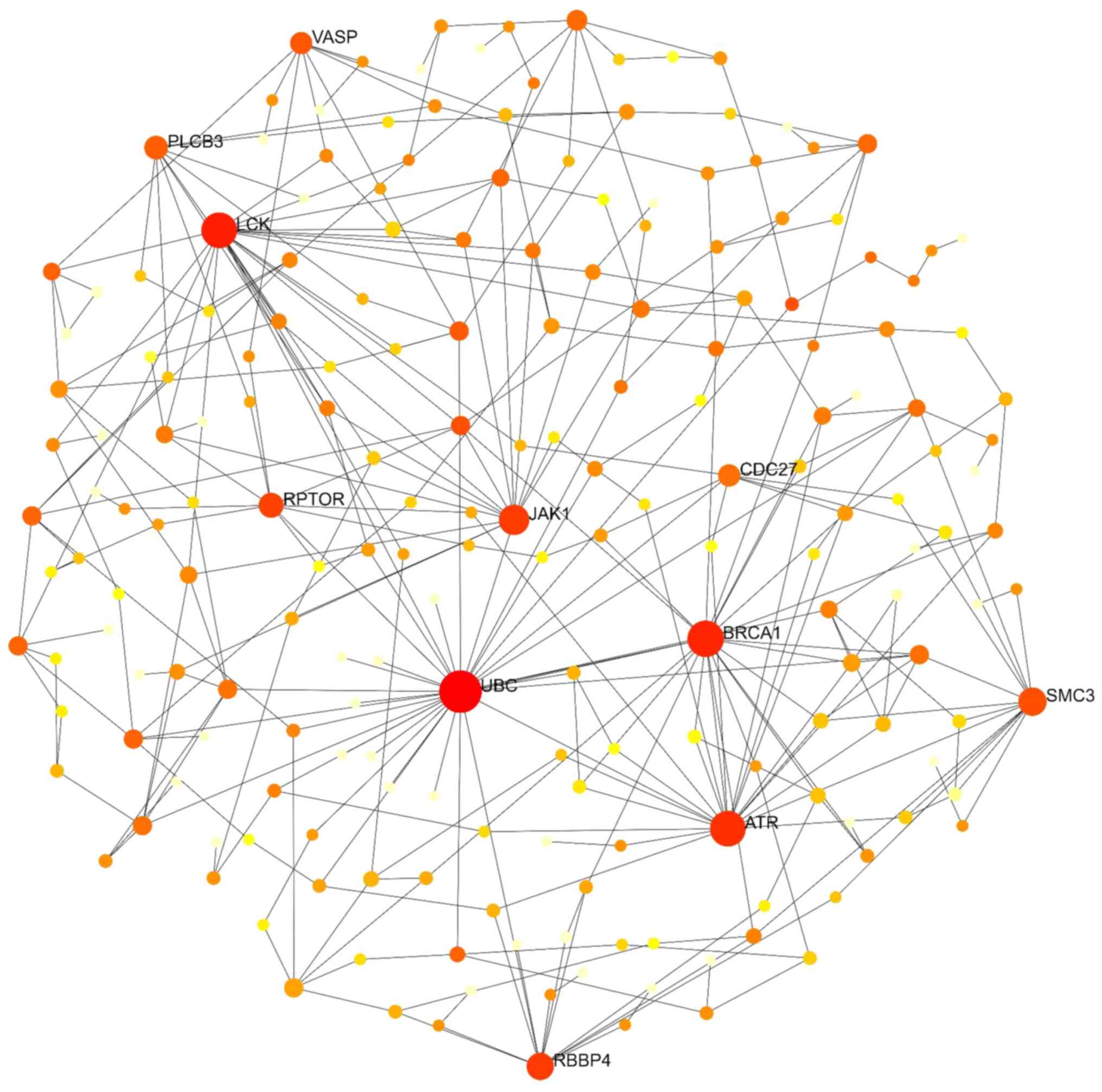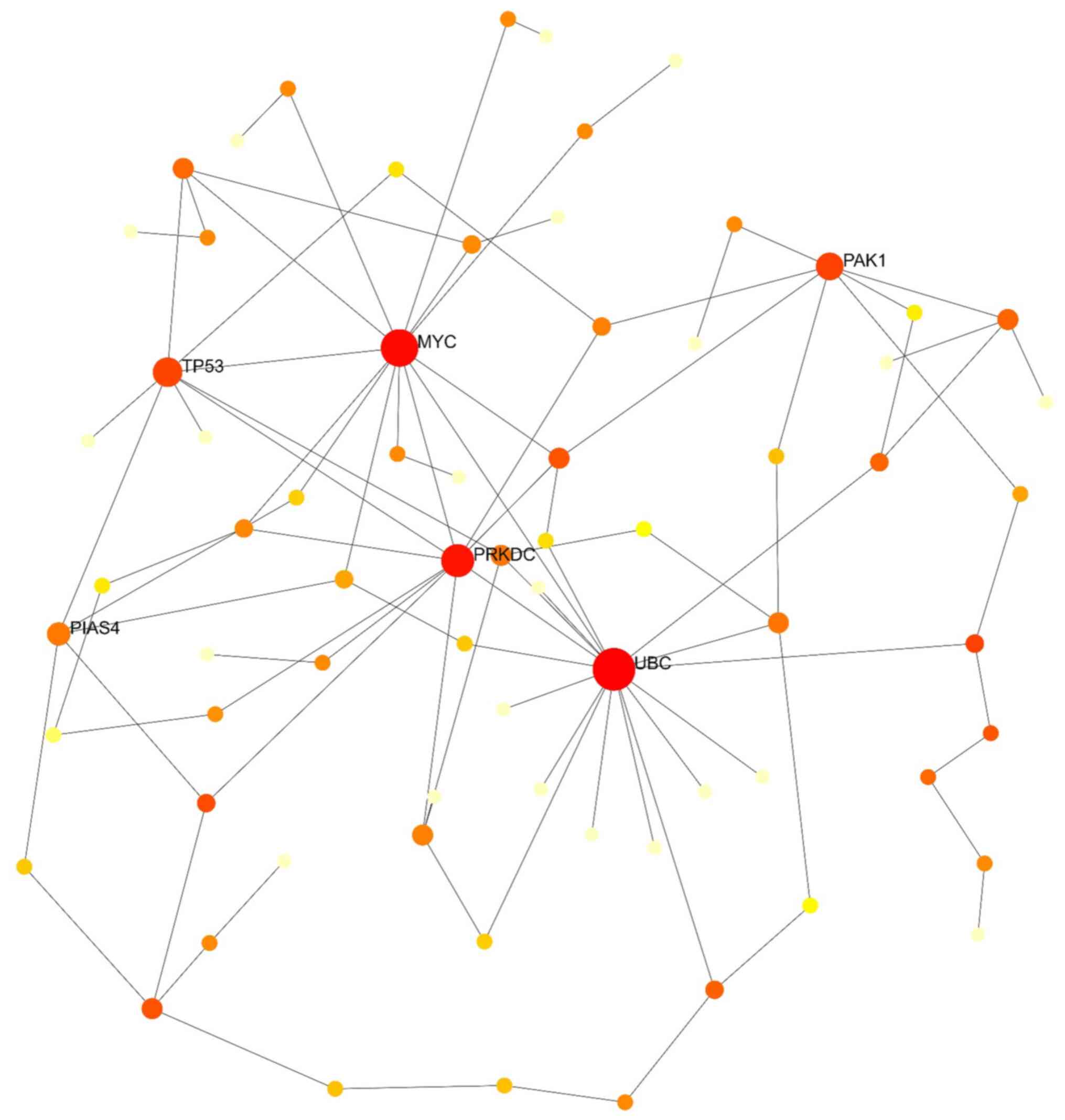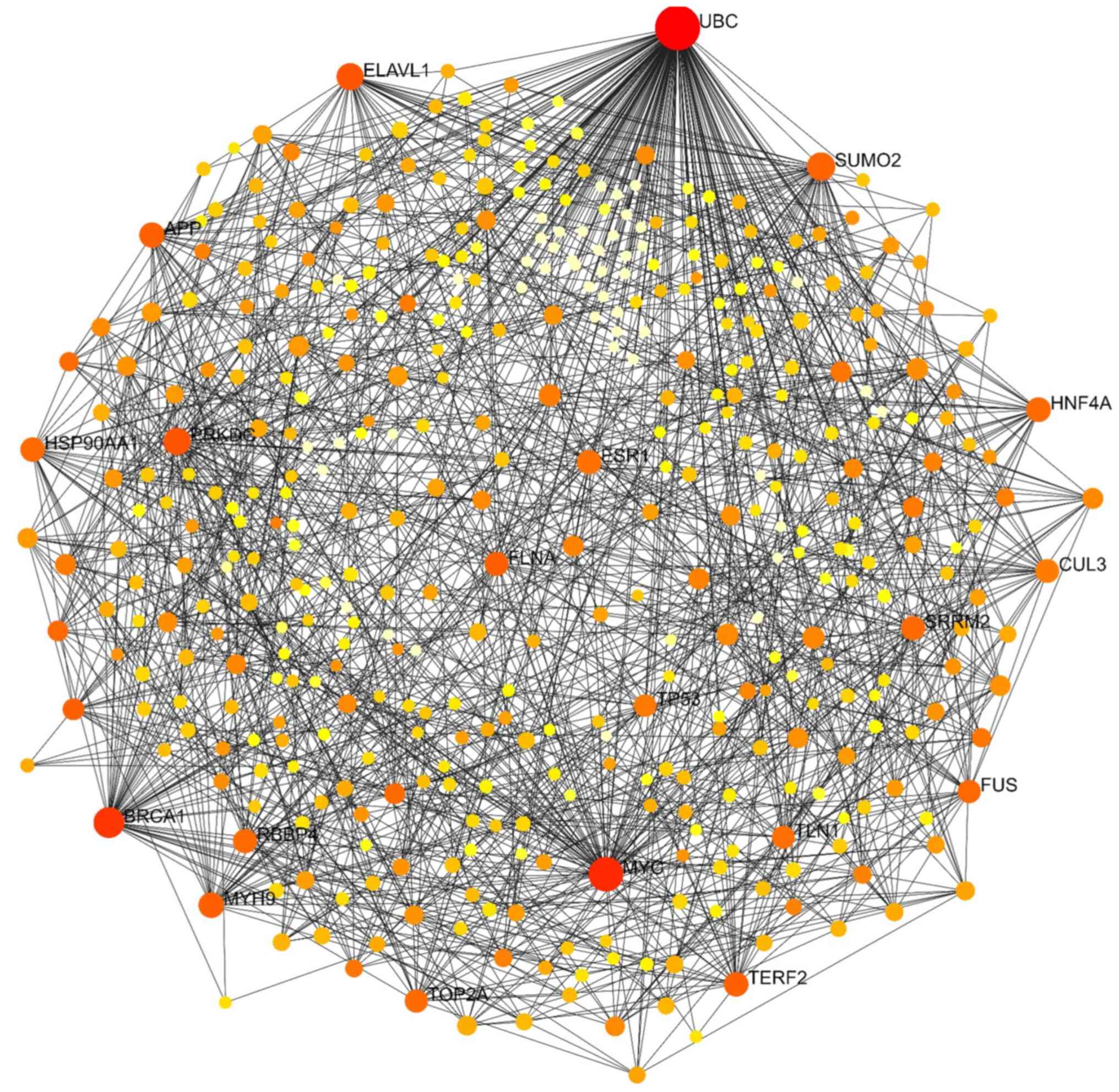|
1
|
Ghai S: Ameloblastoma: An updated
narrative review of an enigmatic tumor. Cureus.
14(e27734)2022.PubMed/NCBI View Article : Google Scholar
|
|
2
|
Vered M and Wright JM: Update from the 5th
edition of the World Health Organization classification of head and
neck tumors: Odontogenic and maxillofacial bone tumours. Head Neck
Pathol. 16:63–75. 2022.PubMed/NCBI View Article : Google Scholar
|
|
3
|
Effiom OA, Ogundana OM, Akinshipo AO and
Akintoye SO: Ameloblastoma: Current etiopathological concepts and
management. Oral Dis. 24:307–316. 2018.PubMed/NCBI View Article : Google Scholar
|
|
4
|
Brown NA and Betz BL: Ameloblastoma: A
review of recent molecular pathogenetic discoveries. Biomark
Cancer. 7 (Suppl 2):S19–S24. 2015.PubMed/NCBI View Article : Google Scholar
|
|
5
|
Chakraborty S, Hosen MI, Ahmed M and
Shekhar HU: Onco-multi-OMICS approach: A new frontier in cancer
research. Biomed Res Int. 2018(9836256)2018.PubMed/NCBI View Article : Google Scholar
|
|
6
|
Sallam RM: Proteomics in cancer biomarkers
discovery: Challenges and applications. Dis Markers.
2015(321370)2015.PubMed/NCBI View Article : Google Scholar
|
|
7
|
Fernández-Puente P, Mateos J, Blanco FJ
and Ruiz-Romero C: LC-MALDI-TOF/TOF for shotgun proteomics. Methods
Mol Biol. 1156:27–38. 2014.PubMed/NCBI View Article : Google Scholar
|
|
8
|
Darie-Ion L, Whitham D, Jayathirtha M, Rai
Y, Neagu AN, Darie CC and Petre BA: Applications of
MALDI-MS/MS-based proteomics in biomedical research. Molecules.
27(6196)2022.PubMed/NCBI View Article : Google Scholar
|
|
9
|
Cui Y, Li H, Xiao T, Zhang X, Hou Y, Li H
and Li X: A proteomics study to explore differential proteins
associated with the pathogenesis of ameloblastoma. J Oral Pathol
Med. 52:528–538. 2023.PubMed/NCBI View Article : Google Scholar
|
|
10
|
Kuleshov MV, Jones MR, Rouillard AD,
Fernandez NF, Duan Q, Wang Z, Koplev S, Jenkins SL, Jagodnik KM,
Lachmann A, et al: Enrichr: A comprehensive gene set enrichment
analysis web server 2016 update. Nucleic Acids Res. 44
(W1):W90–W97. 2016.PubMed/NCBI View Article : Google Scholar
|
|
11
|
Harris MA, Clark J, Ireland A, Lomax J,
Ashburner M, Foulger R, Eilbeck K, Lewis S, Marshall B, Mungall C,
et al: The gene ontology (GO) database and informatics resource.
Nucleic Acids Res. 32 (Database Issue):D258–D261. 2004.PubMed/NCBI View Article : Google Scholar
|
|
12
|
Zhou G, Soufan O, Ewald J, Hancock REW,
Basu N and Xia J: NetworkAnalyst 3.0: A visual analytics platform
for comprehensive gene expression profiling and meta-analysis.
Nucleic Acids Res. 47 (W1):W234–W241. 2019.PubMed/NCBI View Article : Google Scholar
|
|
13
|
Szklarczyk D, Gable AL, Lyon D, Junge A,
Wyder S, Huerta-Cepas J, Simonovic M, Doncheva NT, Morris JH, Bork
P, et al: STRING v11: Protein-protein association networks with
increased coverage, supporting functional discovery in genome-wide
experimental datasets. Nucleic Acids Res. 47 (D1):D607–D613.
2019.PubMed/NCBI View Article : Google Scholar
|
|
14
|
Zhang Y, Sun Z, Jia J, Du T, Zhang N, Tang
Y, Fang Y and Fang D: Overview of histone modification. Adv Exp Med
Biol. 1283:1–16. 2021.PubMed/NCBI View Article : Google Scholar
|
|
15
|
Cao J and Yan Q: Histone ubiquitination
and deubiquitination in transcription, DNA damage response, and
cancer. Front Oncol. 2(26)2012.PubMed/NCBI View Article : Google Scholar
|
|
16
|
Guo XE, Ngo B, Modrek AS and Lee WH:
Targeting tumor suppressor networks for cancer therapeutics. Curr
Drug Targets. 15:2–16. 2014.PubMed/NCBI View Article : Google Scholar
|
|
17
|
Tang DD and Gerlach BD: The roles and
regulation of the actin cytoskeleton, intermediate filaments and
microtubules in smooth muscle cell migration. Respir Res.
18(54)2017.PubMed/NCBI View Article : Google Scholar
|
|
18
|
Nishikawa S: Cytoskeleton, intercellular
junctions, planar cell polarity, and cell movement in amelogenesis.
J Oral Biosci. 59:197–204. 2017.
|
|
19
|
Kiefel H, Bondong S, Hazin J, Ridinger J,
Schirmer U, Riedle S and Altevogt P: L1CAM: A major driver for
tumor cell invasion and motility. Cell Adh Migr. 6:374–384.
2012.PubMed/NCBI View Article : Google Scholar
|
|
20
|
Nagi R, Sahu S and Rakesh N: Molecular and
genetic aspects in the etiopathogenesis of ameloblastoma: An
update. J Oral Maxillofac Pathol. 20:497–504. 2016.PubMed/NCBI View Article : Google Scholar
|
|
21
|
Periayah MH, Halim AS and Saad AZ:
Mechanism action of platelets and crucial blood coagulation
pathways in hemostasis. Int J Hematol Oncol Stem Cell Res.
11:319–327. 2017.PubMed/NCBI
|
|
22
|
Khalele BAEO and Al-Shiaty RA: A novel
marker of ameloblastoma and systematic review of
immunohistochemical findings. Ann Diagn Pathol. 22:18–24.
2016.PubMed/NCBI View Article : Google Scholar
|
|
23
|
Nikitakis NG, Tzerbos F, Triantafyllou K,
Papadimas C and Sklavounou A: Granular cell ameloblastoma: An
unusual histological subtype report and review of literature. J
Oral Maxillofac Res. 1(e3)2011.PubMed/NCBI View Article : Google Scholar
|
|
24
|
Zhang YL, Wang RC, Cheng K, Ring BZ and Su
L: Roles of Rap1 signaling in tumor cell migration and invasion.
Cancer Biol Med. 14:90–99. 2017.PubMed/NCBI View Article : Google Scholar
|
|
25
|
Jia Z, Yang Y, Dengyan Z, Chunyang Z,
Donglei L, Kai W and Song Z: RAP1B, a DVL2 binding protein,
activates Wnt/beta-catenin signaling in esophageal squamous cell
carcinoma. Gene. 611:15–20. 2017.PubMed/NCBI View Article : Google Scholar
|
|
26
|
Pomin VH and Mulloy B: Glycosaminoglycans
and proteoglycans. Pharmaceuticals (Basel). 11(27)2018.PubMed/NCBI View Article : Google Scholar
|
|
27
|
Hassan N, Greve B, Espinoza-Sánchez NA and
Götte M: Cell-surface heparan sulfate proteoglycans as
multifunctional integrators of signaling in cancer. Cell Signal.
77(109822)2021.PubMed/NCBI View Article : Google Scholar
|
|
28
|
Winkler J, Abisoye-Ogunniyan A, Metcalf KJ
and Werb Z: Concepts of extracellular matrix remodelling in tumour
progression and metastasis. Nat Commun. 11(5120)2020.PubMed/NCBI View Article : Google Scholar
|
|
29
|
Listik E, Azevedo Marques Gaschler J,
Matias M, Neuppmann Feres MF, Toma L and Raphaelli Nahás-Scocate
AC: Proteoglycans and dental biology: the first review. Carbohydr
Polym. 225(115199)2019.PubMed/NCBI View Article : Google Scholar
|
|
30
|
Gómez-Herrera Z, Molina-Frechero N,
Damián-Matsumura P and Bologna-Molina R: Proteoglycans as potential
biomarkers in odontogenic tumors. J Oral Maxillofac Pathol.
22:98–103. 2018.PubMed/NCBI View Article : Google Scholar
|
|
31
|
Barkovskaya A, Buffone A Jr, Žídek M and
Weaver VM: Proteoglycans as mediators of cancer tissue mechanics.
Front Cell Dev Biol. 8(569377)2020.PubMed/NCBI View Article : Google Scholar
|
|
32
|
Yu D, Lim J, Wang X, Liang F and Xiao G:
Enhanced construction of gene regulatory networks using hub gene
information. BMC Bioinformatics. 18(186)2017.PubMed/NCBI View Article : Google Scholar
|
|
33
|
Li CY, Cai JH, Tsai JJP and Wang CCN:
Identification of hub genes associated with development of head and
neck squamous cell carcinoma by integrated bioinformatics analysis.
Front Oncol. 10(681)2020.PubMed/NCBI View Article : Google Scholar
|
|
34
|
Sun T, Liu Z and Yang Q: The role of
ubiquitination and deubiquitination in cancer metabolism. Mol
Cancer. 19(146)2020.PubMed/NCBI View Article : Google Scholar
|
|
35
|
Che Z, Sun H, Yao W, Lu B and Han Q: Role
of post-translational modifications in regulation of tumor
suppressor p53 function. Front Oral Maxillofac Med. 2:1–15.
2020.
|
|
36
|
Zhong M, Li Z, Wang J, Zhang B, Hou L and
Gong YB: Expression of telomerase activity and c-myc and
stimulatory protein 1 in human ameloblastoma. Hua Xi Kou Qiang Yi
Xue Za Zhi. 22:499–502. 2004.PubMed/NCBI(In Chinese).
|
|
37
|
Acosta JC and Gil J: Senescence: A new
weapon for cancer therapy. Trends Cell Biol. 22:211–219.
2012.PubMed/NCBI View Article : Google Scholar
|
|
38
|
Aebersold R and Mann M: Mass
spectrometry-based proteomics. Nature. 422:198–207. 2003.PubMed/NCBI View Article : Google Scholar
|
|
39
|
da Silva Marcelino BMR, Parise GK, do
Canto AM, Sassi LM, Sarmento DJS, Costa ALF, Hasséus B, Kjeller G,
Schussel JL and Braz-Silva PH: Comparison of immunohistochemistry
and DNA sequencing for BRAF V600E mutation detection in mandibular
ameloblastomas. Appl Immunohistochem Mol Morphol. 29:390–393.
2021.PubMed/NCBI View Article : Google Scholar
|
|
40
|
Lapthanasupkul P, Laosuk T,
Ruangvejvorachai P, Aittiwarapoj A and Kitkumthorn N: Frequency of
BRAF V600E mutation in a group of Thai patients with
ameloblastomas. Oral Surg Oral Med Oral Pathol Oral Radiol.
132:e180–e185. 2021.PubMed/NCBI View Article : Google Scholar
|



